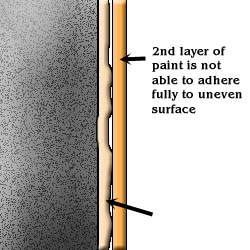Case 1
- Introduction
- Causes of Defects
- Good Practices
- Standards
- Maintenance and Diagnostics
- Remedial
- Similar Cases
- References
Cause of Defects
The cause is generally similar to that of cracking:
- too thick a film
- too soft an undercoat, insufficient drying between coats
Alligatoring is usually formed due to various reason. In some instance, the base coat was unable to dry completely before the topcoat was applied. The top coat thus does not get a good grip, and alligator ensue.



Lack of bonding between the substrate and the paint can be a cause. This is especially true with shiny and glossy surfaces. Incorrect application such as applying an extremely hard coating over a soft primer coat can result in paint alligatoring (Figure 1a to c).
Application of low-grade paint with poor adhesion qualities can readily flake off by itself.
The hide of an alligator would be formed and this may affect visual appearance of the façade. In certain circumstances, the peeling of the pain due to low-grade paint may further worsen the appearance.
If alligatoring remains unrepaired, water might seep through and behind the paint film causing the whole paint system to fail.